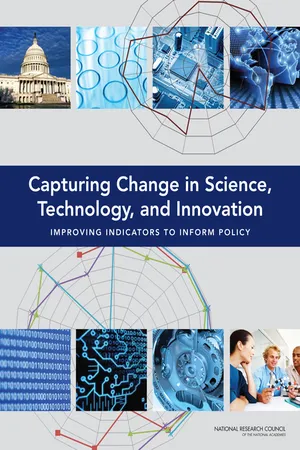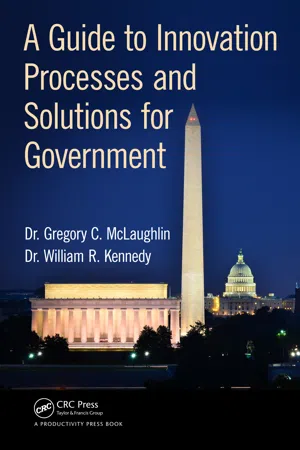Business
Assessing Innovation
Assessing innovation involves evaluating the effectiveness and impact of new ideas, products, or processes within an organization. This assessment typically includes analyzing factors such as market potential, feasibility, and potential risks. By systematically evaluating innovation, businesses can make informed decisions about resource allocation and strategic direction.
Written by Perlego with AI-assistance
Related key terms
1 of 5
4 Key excerpts on "Assessing Innovation"
- eBook - PDF
- (Author)
- 0(Publication Date)
- The National Academies Press(Publisher)
Advisory Committee on Measuring Innovation in 21st Century Economy, Department of Commerce 2008 An innovation is the implementation of a new or significantly improved product (good or service), or process, a new marketing method, or a new organizational method in business practices, workplace organization or external relations. Innovation activities are all scientific, technological, orga- nizational, financial and commercial steps which actually, or are intended to, lead to the implementation of innovations. OECD-Eurostat 2005 Innovation success is the degree to which value is created for customers through enterprises that transform new knowledge and technologies into profitable products and services for national and global markets. A high rate of innovation in turn contributes to more market creation, economic growth, job creation, wealth and a higher standard of living. Innovation Vital Signs Project 2007 SOURCE: Aizcorbe et al. (2009). Capturing Change in Science, Technology, and Innovation: Improving Indicators to Inform Policy Copyright National Academy of Sciences. All rights reserved. MEASURING INNOVATION 43 WHY MEASURE INNOVATION? The underlying analytical framework used in this study posits that new and improved products and processes, new organizational methods, and new marketing concepts and strategies are key measures of the output of a country’s innovation system. Innovation affects both economic per- formance measures, such as productivity growth, profits, and job creation, and noneconomic variables, such as life expectancy and environmental response. Meanwhile, the rate of innovation responds to inputs such as R&D spend- ing; the availability of science, technology, engineering, and mathematics (STEM) labor; regulatory policies; and other variables. 3 From this perspective, the panel strongly believes that NCSES needs to improve its ability to measure and track innovation. - Gregory C. McLaughlin DBA, William R. Kennedy DBA(Authors)
- 2015(Publication Date)
- CRC Press(Publisher)
Judge the value of the innovation opportunity on (check all that apply) □ How new or novel it is □ How many people it involves □ How much it costs □ How long it takes □ How much improvement occurs □ How much benefit it provides □ The extent of the change that occurs Interpretation A variety of responses confirms our assertion that innovation means many things to many people. Assessing the organiza-tion will assist in establishing long- and short-term objec-tives at the strategic, operational, and tactical levels as well as broaden the scope of innovation. Use the results from this assessment to help define the expected outcomes of an orga-nization-wide effort. Often, this information leads to a filtering process intended to logically group (by function or topic) objectives that reduce Organizational Assessment ◾ 111 their number. Be careful to include measures that relate to people, policies, procedures, processes, products, or services and select objectives that are easily measured. For instance, it would be great to have an objective that states that employee morale will increase with innovation. The problem lies in measuring morale objectively and accurately, which is situation dependent. The goal here is to select measures that define the innovation outcome. Actions This simple survey does not require any calculations. Collect the data and graph the responses in Excel for each of the three questions. Expect your responses to be as varied as shown in Figure 6.1. Conducting an 80/20 rule analysis would consider only those questions with a score of 9 or higher (these are considered possible success criteria) (Figure 6.1). The important element is the diversity of responses that rein-force the concept that measuring innovation success covers a wide range of criteria from organizational to human issues. 16 10 Proactive Leadership Employee Collaboration Effective Communications An Effective Method or...- eBook - PDF
Agricultural Innovation Systems
An Investment Sourcebook
- World Bank(Author)
- 2012(Publication Date)
- World Bank(Publisher)
In addition to clarifying the objectives of an assessment, it is also important to identify who will use the results. Assessments may be carried out by organizations that fund, or intend to fund, organizations within the innovation sys- tem. However, assessment results need to be fed back to the management of the organizations involved to stimulate institutional learning and change. Moreover, as discussed below, assessments benefit from the involvement of staff members as well as users of innovation-related services. Another primary task is to select the standard or reference situation against which an organization’s performance within the innovation system can be assessed. The following options may be considered: ■ Benchmarking. One approach is to compare the organi- zations within the system in a particular country with those of other countries, typically countries in the same region or countries that are otherwise comparable. If quantitative indicators are used, this approach is known as “benchmarking.” ■ Changes over time. Another approach (which can be combined with benchmarking) is to compare the perfor- mance of the organization at different points in time and determine whether it improved or deteriorated. ■ Policy goals, organizational objectives, or standards. A third approach is to compare organizations against goals that have been set by policy makers, by managers of the respective organization, or by another entity, such as a donor organization or certification or accreditation agency. - eBook - PDF
The Quadruple Innovation Helix Nexus
A Smart Growth Model, Quantitative Empirical Validation and Operationalization for OECD Countries
- Sara Paulina De Oliveira Monteiro, Elias G. Carayannis, Sara Paulina De Oliveira Monteiro, Elias G. Carayannis(Authors)
- 2017(Publication Date)
- Palgrave Macmillan(Publisher)
Nevertheless, in spite of Fig. 7.8 Innovation measurement at firm level—a return on innovation approach 200 I. CAETANO supporting innovation management and guiding an internal diagnosis concerning innovation determinants (Smith et al. 2008; van der Panne et al. 2003), this tool does not capture value created by innovation. The model proposed addresses those limitations and includes the busi- ness innovation cycle in its context as firms are not isolated units. A systemic approach facilitates then our understanding of the different components represented and its linkages, influences and interdependences with micro and macro environment elements: 1. Innovation Business Determinants: innovation evaluation and mea- surement at firm level, as previously suggested by researchers (Adams et al. 2006; Dervitsiotis 2010; Muller et al. 2005), must include a regular and systematic process addressing innovation determinants included in a broad spectrum of areas, for example culture, strategy, governance, processes and innovation results. 2. Innovation Process Cycle: transformation of ideas and knowledge into innovative results (product, process, organisational, marketing, social, business model innovations, etc.) requires a formalised process, normally associated with new product development methodologies that reflect also evaluation and measurement in order to check the agility, speed, flexibility and capabilities in maintaining a healthy innovation portfolio, in an ambidextrous perspective, as a relevant axis of business sustainability. 3. Innovation Activities and Projects: innovation activities and projects are at the core of innovative firms. In our model, a ROI approach can be applied to this building block as it is possible to link to accounting procedures in order to evaluate and measure innovation effects in different levels, including the possibility of associating direct costs and profits to the activity or project that is subject to analysis.
Index pages curate the most relevant extracts from our library of academic textbooks. They’ve been created using an in-house natural language model (NLM), each adding context and meaning to key research topics.



